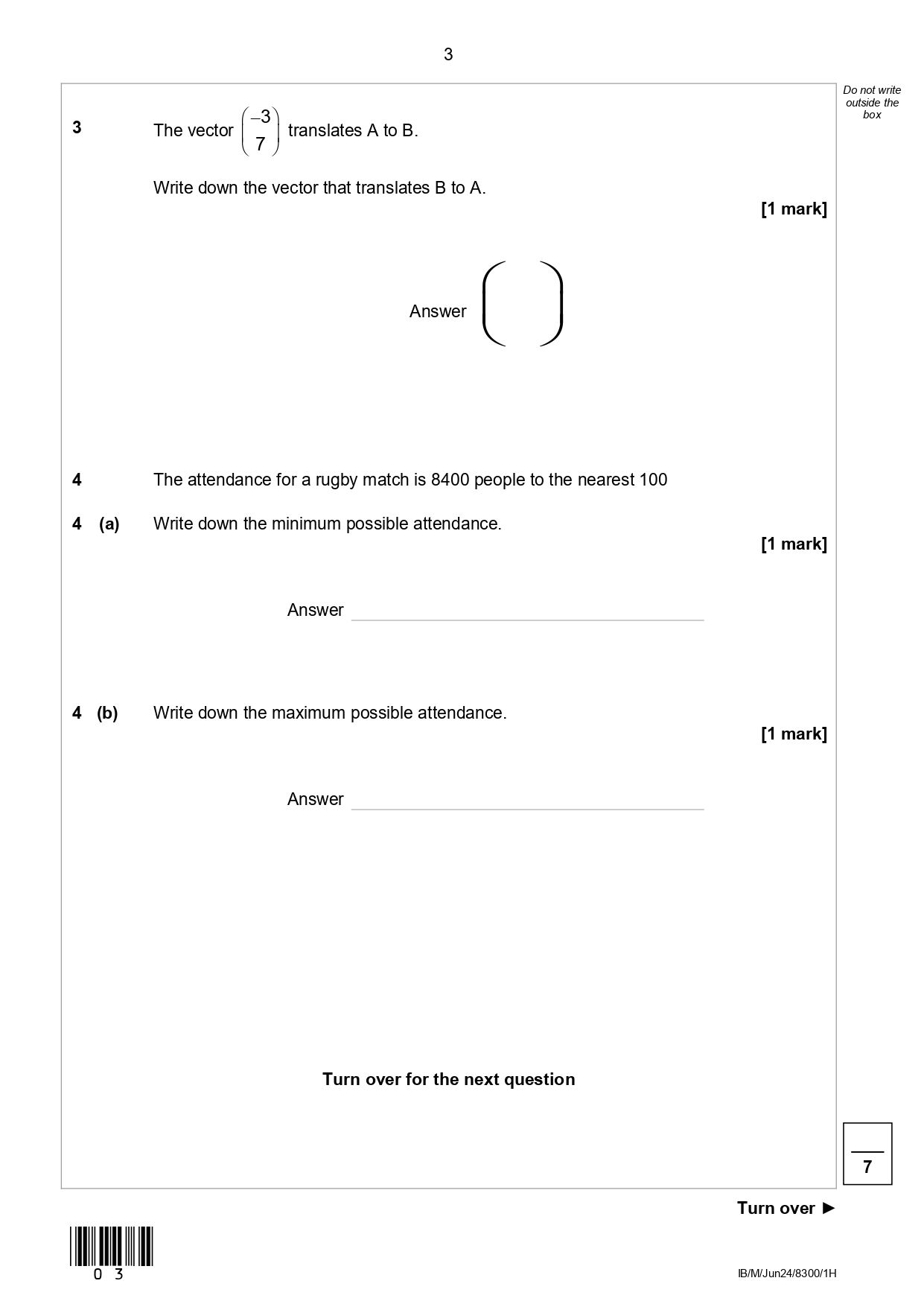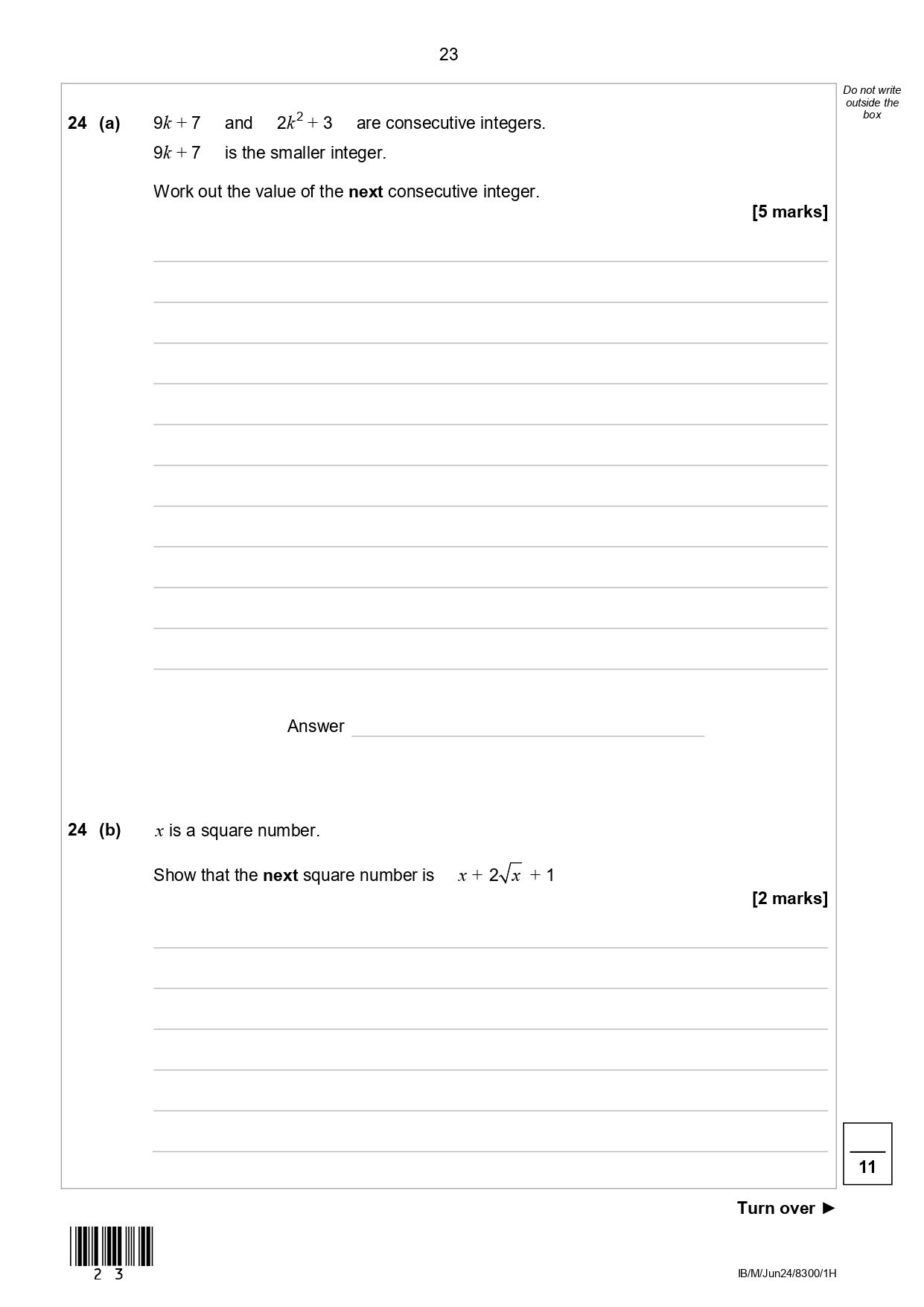Contents
Are you taking GCSE Maths with AQA? If you’ve got questions on what to expect, take a look at this guide.
Exam boards assess knowledge differently, so it’s important to get accurate information on what to expect in the exam and how it will be marked. This guide will help you understand what the Maths GCSE will look like with AQA and give top tips on how to prepare.
Unsure which exam board your school has selected? Take a look at our guide to finding out which exam board you’re studying.
Key takeaways:
There are three papers in the AQA GCSE Maths exam, and each one counts for a third of your overall Maths grade.
The grade boundaries for Maths AQA are set after exams take place to make sure grades are fair.
A formula sheet will be included for AQA Maths GCSEs in 2025, 2026, and 2027.
AQA GCSE Maths past papers can be found on the AQA website.
What’s the format for AQA Maths?
To make the GCSE journey less mysterious, here’s a rundown on the format of the AQA Maths exams, including how many papers there are, how long each paper lasts, their structure, and the kinds of questions and marks you will face.
How many papers are there?
There are three exam papers for AQA GCSE Maths, for both the Foundation and Higher tiers.
All content from the AQA GCSE Maths course can be tested in any of the three exam papers, with questions often combining topics from across the curriculum.
The three papers are:
Written exam: 1 hour 30 minutes
80 marks
Non-calculator
Counts for one-third (33%) of the total GCSE AQA Maths grade.
What’s the difference between Higher and Foundation?
As you can see, the format of the two Maths tier papers is the same. The key difference between the two is how challenging the questions are and the grades available.
Foundation tier Maths AQA:
Covers the essential topics students need to know that will prepare them for further study, work and everyday life.
In Foundation Maths, students can achieve grades 1,2,3,4, and 5, but no higher.
Higher tier Maths AQA:
The higher tier covers more advanced topics such as: more complex Algebra, higher-level Geometry, and deeper Functions.
For Higher tier Maths, students can achieve grades 3-9, but no lower.
Your school will place you in the correct tier based on your performance in Year 9. Sometimes, students may be moved up or down a tier during Year 10 or 11.
AQA requires all exams to be taken at the same level, so you cannot do Higher for one part and Foundation for another.
How long is the exam?
Each paper is 1 hour and 30 minutes (90 minutes) long.
If you're entitled to 25% extra time, you'll have 1 hour 53 minutes per paper.
All papers are set on separate days, usually spread across the exam period in May and June.
What does the exam paper look like?
Each paper will include:
An instructions page: This is where students will need to fill in their personal details and where they can read through the materials, instructions, information and advice for each AQA Maths paper.
The question booklet: This will include all the questions and where students will write their answers and show their working out.
Additional pages: These are for extra space to include working out, if needed. Students must write the question number in the left-hand margin to ensure they don’t lose marks.
What kinds of questions are there?
For each of the papers, a mix of question styles will appear. The difficulty increases as you progress through the paper.
Towards the start of the paper, short, one or two-mark questions will appear:

Pictured: The first page from Higher Tier, Paper 1 AQA GCSE Maths June 2024.
As you progress through the paper, multi-step problems with more marks will be included, requiring deeper thinking:

Pictured: Higher Foundation Tier, Paper 1 AQA GCSE Maths June 2024.
Each AQA GCSE Maths paper is worth 80 marks in total. The number of marks for a question shows how much detail or working is needed.
Short, 1–2 mark questions are simpler, while the later questions can be worth up to 8 marks and usually require more steps and reasoning.
Here's a breakdown of the types of questions you'll find by number of marks:
1-mark questions:
These are often simple recall, single-step arithmetic, or quick fact questions.
They test basic skills: e.g. “Write ⅗ as a decimal,” “What is 7 × 8?”, “Calculate 15% of 80.”
They don’t require extended working. One line or even just the answer is enough (though working is beneficial in case of slips).
They’re designed to build confidence early in the paper.
Medium-mark questions (2–5 marks):
These questions require a few more steps to solve, and ask students to demonstrate more thought and understanding.
You may need to show intermediate workings or justify a step.
The mark scheme will award method marks (for correct setup or steps) as well as final answer marks.
Higher-mark, multi-step / reasoning questions (6, 7, 8+ marks):
These ask you to combine multiple areas of Maths: Algebra, Geometry, Statistics or Ratio, in context.
They often include “show that”, “explain why”, “prove”, or “justify” wording.
You must lay out a clear method, break down steps, and sometimes consider alternative approaches or show reasoning.
Marks are split into different types. You can earn method marks for showing the correct steps and working, and accuracy marks for getting the right answers. Some questions also award extra marks for giving a clear explanation or justification at the end.
Even if the final answer is wrong, partial marks can be earned for correct working.
For the higher mark questions, students must show their working out.
What are the grade boundaries for AQA Maths GCSE?
It’s important to remember that the exact grade boundaries for your GCSE exams will change every year.
Exam boards adjust the grade boundaries after an exam has happened, depending on how advanced the exam content was and how the cohort performed. This is so students don’t have an advantage or disadvantage because of the year they took the paper. For example, if your paper were harder, grade boundaries would be lowered so that a grade 5 reflects the same level of knowledge as in previous years.
The grade boundaries for AQA Maths in 2026 are not yet known, but we’ve taken a look at the previous year’s data to give you an idea of what to expect.
In recent years, grade 9s hovered between 214 and 219 marks out of 240.
Grade 8s fell between 184 and 191, and grade 7s between 157 and 164.
The standard pass for a grade 4 on the Higher paper tended to be in the 60s. Last year it was 63 marks, and before that 61.
On Foundation papers, grade 5 required 186 to 188 marks, with a grade 4 around 150 to 160.
The changes in grade boundaries year on year are often not huge. The biggest drops will be if a more difficult paper is set, but don’t worry - exam boards take care of making sure grading is fair and consistent for your year group.
If the results aren’t what you’d hoped for, you can ask for your paper to be remarked. But be careful, you can lose marks too in remarking!
As a reminder, take a look at our blog on how GCSE exams are graded.
Where can I find past papers and mark schemes?
Practising with past papers and mark schemes is one of the most effective ways to prepare for GCSE AQA Maths. Past papers help you understand the question style, see how marks are awarded, and build confidence with real exam timing and structure.
Head to the AQA website to find past papers and mark schemes from previous GCSE AQA Maths exams.
What key topics do I need to know for the AQA Maths GCSE?
AQA Maths tests several key topics at GCSE. You’ll need a thorough understanding of each topic, and it’s important to make sure you revise the areas you find most difficult ahead of the exam.
The topics are:
Number: This topic tests your understanding of things like units of measure, fractions and prime numbers.
Algebra: For this topic, you’ll be tested on expanding and simplifying algebraic equations, plotting and understanding graphs, and more.
Ratio, Proportion and Rates of Change: This topic involves understanding concepts such as compound units, scale diagrams, and direct and inverse proportion.
Geometry and Measure: Here you’ll need to understand properties of angles, coordinate axes, rotation, reflection, translation and enlargement, among other things.
Probability: This involves calculating the likelihood of outcomes in future experiments, understanding the probability scale, using tree diagrams, and more.
Statistics: For Statistics, you’ll need to interpret and construct charts, graphs and diagrams, understand population data, understand correlation and more.
If you’re taking Further Maths, you’ll also be tested on topics like Functions, Coordinate Geometry, Calculus and Matrix Transformations.
What are examiners looking for?
When marking AQA GCSE Maths papers, examiners aren’t just checking for the right answers; they want to see how you think. They’re looking for clear working, sensible explanations and answers that show genuine understanding of the questions.
Every question on the paper is written to show examiners what a student can really do. Each question tests one or more of the three Assessment Objectives (AOs), which helps examiners assess how well a student can apply Maths to solve problems.
The three assessment objectives are:
1. AO1 – Applying standard techniques
This is about using mathematical skills and methods correctly. Examiners look for accuracy in calculations, correct use of formulae, and clear working.
Questions that assess AO1 often involve number work, algebraic manipulation, or Geometry. Students are rewarded for demonstrating the correct method, even if they make a mistake in their calculations.
2. AO2 – Reasoning, interpreting and communicating
Here, examiners want to see a student’s ability to think logically and explain their process. AO2 is about showing why something works, not just how to do it.
Students might need to compare results, interpret graphs, or explain relationships between numbers. Clear reasoning and well-presented answers are key; examiners are looking for clear, logical thinking just as much as the correct final answer.
3. AO3 – Solving problems in context
This objective focuses on applying Maths to real-life or unfamiliar situations. Examiners are assessing how well students can choose the right method, link different areas of Maths, and make sense of their answers.
AO3 questions often require several steps and reward logical reasoning and a clear understanding of the problem, not just the final answer.
Every AQA Maths paper provides you with the opportunity to demonstrate what they truly understand. The best way to impress examiners is to approach each question step by step, show the working clearly, and check that your answers make sense.
By practising this approach regularly, you build the habits examiners look for: clear working, logical thinking, and confidence in tackling unfamiliar problems. It’s these skills, developed over time, that help turn preparation into strong, well-earned marks on exam day.
How can I prepare for AQA Maths?
To prepare for AQA Maths exams, you’ll need to start revising early to make sure you’re confident covering all the key topics. For exam revision tips for Maths, take a look at our Maths breakdown here.
What do I need to bring to the exam?
Feeling calm and prepared on exam day starts with having everything you need ready to go. For AQA GCSE Maths, what you’ll need for exam day depends slightly on which paper you’re sitting.
For Paper 1, you’ll need:
A black pen (bring a few spares!)
Pencil, ruler, rubber, and sharpener.
Protractor and compass for geometry questions.
For Papers 2 and 3, you’ll need everything above, plus a scientific calculator that meets exam board regulations. Make sure it’s in good condition with fresh batteries and that you’re confident using all its functions.
Finally, beyond Maths equipment, there are a few other essentials you’ll need for exam day:
Make sure to have a clear pencil case.
A bottle of water with no label.
If you’re wearing a school uniform, pack a jumper in case the exam hall is cold.
If your school allows non-uniform, choose clothes that feel comfortable and relaxed, so you can focus fully on the paper, not your outfit.
If you wear glasses, double-check they are packed the night before.
Bring any medications you may need, for example, your inhaler if you’re asthmatic.
Is there a formula sheet for AQA Maths?
Don’t worry, there is a formula sheet provided for AQA Maths, so you don’t need to memorise formulas like Pythagoras’ theorem. The DfE has confirmed that formula sheets will continue to be provided for 2025, 2026 and 2027.
What’s included on the formula sheet?
The formula sheet will include formulas for:
Perimeter area and volume
Quadratic formula
Pythagoras’ Theorem and trigonometry
Coordinate geometry
There you have it! Everything you need to know to feel confident tackling AQA Maths at GCSE. Whether you’re taking the exam yourself or supporting your teen, proper preparation and revision are the keys to exam success.
Don’t miss Atom’s GCSE giveaway!

Six months. Six epic prizes. Six chances to make the GCSE season unforgettable.
We’re launching Atom for GCSE prep in 2026, and to celebrate, over the next six months, we’re giving away thousands of pounds worth of prizes to help your child level up their GCSE revision.
Here’s a taste of what’s up for grabs:
The latest Apple tech, including an iPad Air, Vision Pro and more
Festival tickets for Boardmasters and Reading 2026
Europe interrail passes and £1,000 spending money
…and that’s just a few of the amazing prizes available.
Our September winner has already taken home an incredible prize! Find out who it was and what they won in our latest giveaway update.
It’s free to join. UK only. Full T&Cs apply.
Contents
